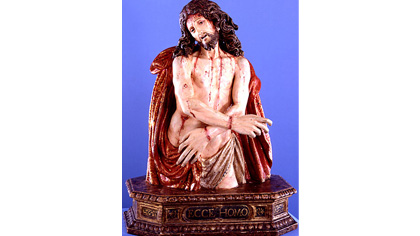Ecce Homo
Ecce Homo, ca. 1600
Spain
Polychromed wood with estofado
Gift of Mrs. Janet Relos, 1916-81
This sculpture illustrates the moment in Christ's life when Pilate presented Him to the crowd after being scourged and mocked. Pilate declared, "Ecce Homo," ("Behold the Man!") and the crowd responded by calling for His crucifixion (John 19:4-6). Christ wears the red robe of feigned royalty while scars on the wrists suggest that He was bound with cords.
From 1580 to 1780 in Spain, devotional images of the Virgin and Christ, particularly those related to the Passion, became predominant. In the last decade of the 16th century, expanding upon the decrees of the Council of Trent, artists were instructed that Christ must be depicted as bleeding, afflicted, spat upon, with skin torn, wounded, deformed, pale, and unsightly. This pathos is vividly expressed in the Ecce Homo figure. The artist has lavished attention on the wounds by cutting deeply into the gesso and wood, adding bluish bruises and impaled thorns. Through beads of ruby glass, the blood glistens with astonishing veracity. The intense realism of Christ's suffering is intended to elicit an emotional response from the viewer.


